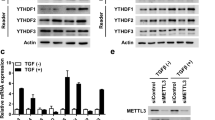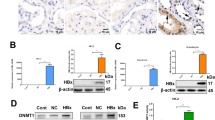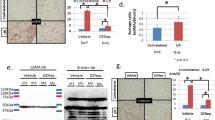Abstract
Renal fibrosis is the most common outcome of chronic kidney disease (CKD), while the pathogenesis of renal fibrosis is not fully understood. In this study, we first showed that the progress of renal fibrosis was positively related to serum levels of indoxyl sulfate, a typical protein-bound toxin, and that there was a close correlation between serum indoxyl sulfate levels and β-catenin expression in the kidneys (r = 0.908, p < 0.001) of CKD patients. We then demonstrated that intraperitoneal injections of indoxyl sulfate (100 mg/kg/day) for 4 weeks in uninephrectomized mice explicitly induced renal fibrosis, which was accompanied by a significant activation of Wnt/β-catenin signaling. In vitro investigations in human renal tubular HK-2 cells revealed that indoxyl sulfate exhibited a potent ability to induce Wnt/β-catenin activation through the downregulation of sFRP5, a gene that codes for an extracellular antagonist of Wnt signaling, by increasing the DNA methylation level of its promoter CpG islands. The increased expression of DNA methyltransferases following the activation of ROS/ERK1/2 signaling was responsible for the DNA hypermethylation of sFRP5 induced by indoxyl sulfate. Conversely, treatment with 5-aza-2′-deoxycytidine, an inhibitor of DNA methyltransferases, significantly reduced indoxyl sulfate-induced sFRP5 downregulation and Wnt/β-catenin activation. In vivo, intraperitoneal injections of recombinant sFRP5 protein or 5-aza-2′-deoxycytidine substantially alleviated renal fibrosis in indoxyl sulfate-treated uninephrectomized mice. Our results suggest that indoxyl sulfate promotes renal fibrosis through the induction of DNA hypermethylation of sFRP5, and thereafter the activation of Wnt/β-catenin signaling. These findings provide new insights into the pathogenesis of renal fibrosis in CKD patients.
Key messages
-
IS induces renal fibrosis by increasing ß-catenin expression in CKD mice.
-
IS-induced Wnt signaling activation is due to sFRP5 hypermethylation in HK-2 cells.
-
ROS/ERK1/2 signaling activation is involved in IS-induced sFRP5 hypermethylation.
-
sFRP5 upregulation attenuates IS-induced renal fibrosis by inhibiting Wnt signaling.








Similar content being viewed by others
References
Nangaku M (2006) Chronic hypoxia and tubulointerstitial injury: a final common pathway to end-stage renal failure. J Am SocNephrol 17(1):17–25
Zeisberg M, Neilson EG (2010) Mechanisms of tubulointerstitial fibrosis. J Am SocNephrol 21(11):1819–1834
Nath KA (1992) Tubulointerstitial changes as a major determinant in the progression of renal damage. Am J Kidney Dis 20(1):1–17
Ruiz-Ortega M, Egido J (1997) Angiotensin II modulates cell growth-related events and synthesis of matrix proteins in renal interstitial fibroblasts. Kidney Int 52(6):1497–1510
Chade AR, Mushin OP, Zhu X, Rodriguez-Porcel M, Grande JP, Textor SC, Lerman A, Lerman LO (2005) Pathways of renal fibrosis and modulation of matrix turnover in experimental hypercholesterolemia. Hypertension 46(4):772–779
Lin CL, Wang JY, Ko JY, Huang YT, Kuo YH, Wang FS (2010) Dickkopf-1 promotes hyperglycemia-induced accumulation of mesangial matrix and renal dysfunction. J Am SocNephrol 21(1):124–135
Kim J, Seok YM, Jung KJ, Park KM (2009) Reactive oxygen species/oxidative stress contributes to progression of kidney fibrosis following transient ischemic injury in mice. Am J Physiol Renal Physiol 297(2):F461–F470
Duranton F, Cohen G, De Smet R, Rodriguez M, Jankowski J, Vanholder R, Argiles A, European Uremic Toxin Work Group (2012) Normal and pathologic concentrations of uremic toxins. J Am SocNephrol 23:1258–1270
Wu IW, Hsu KH, Hsu HJ, Lee CC, Sun CY, Tsai CJ, Wu MS (2012) Serum free p-cresyl sulfate levels predict cardiovascular and all-cause mortality in elderly hemodialysis patients-a prospective cohort study. Nephrol Dial Transplant 27:1169–1175
Barreto FC, Barreto DV, Liabeuf S, Meert N, Glorieux G, Temmar M, Choukroun G, VanholderR MZA, European Uremic Toxin Work Group (EUTox) (2009) Serum indoxyl sulfate is associated with vascular disease and mortality in chronic kidney disease patients. Clin J Am SocNephrol 4(10):1551–1558
Lekawanvijit S, Adrahtas A, Kelly DJ, Kompa AR, Wang BH, Krum H (2010) Does indoxyl sulfate, a uraemic toxin, have direct effects on cardiacfibroblasts and myocytes? Eur Heart J 31(14):1771–1779
Lin CJ, Pan CF, Liu HL, Chuang CK, Jayakumar T, Wang TJ, Chen HH, Wu CJ (2012) The role of protein-bound uremic toxins on peripheral artery disease and vascular access failure in patients on hemodialysis. Atherosclerosis 225(1):173–179
Watanabe H, Miyamoto Y, Honda D, Tanaka H, Wu Q, Endo M, Noguchi T, Kadowaki D, Ishima Y, Kotani S et al (2013) p-Cresyl sulfate causes renaltubular cell damage by inducing oxidative stress by activation of NADPH oxidase. Kidney Int 83(4):582–592
Sun CY, Hsu HH, Wu MS (2013) p-Cresol sulfate and indoxylsulfate induce similar cellular inflammatory gene expressions in cultured proximal renaltubular cells. Nephrol Dial Transplant 28(1):70–78
Shimizu H, Bolati D, Adijiang A, Muteliefu G, Enomoto A, Nishijima F, Dateki M, Niwa T (2011) NF-κB plays an important role in indoxylsulfate-induced cellular senescence, fibrotic gene expression, and inhibition of proliferation in proximal tubular cells. Am J Physiol Cell Physiol 301(5):C1201–C1212
He W, Dai C, Li Y, Zeng G, Monga SP, Liu Y (2009) Wnt/beta-catenin signaling promotes renal interstitial fibrosis. J Am SocNephrol 20(4):765–776
Surendran K, Schiavi S, Hruska KA (2005) Wnt-dependent beta-catenin signaling is activated after unilateral ureteral obstruction, and recombinant secreted frizzled-related protein 4 alters the progression of renal fibrosis. J Am SocNephrol 16(8):2373–2384
Finch PW, He X, Kelley MJ, Uren A, Schaudies RP, Popescu NC, Rudikoff S, Aaronson SA, Varmus HE, Rubin JS (1997) Purification and molecular cloning of a secreted, frizzled-related antagonist of Wnt action. Proc Natl Acad Sci U S A 94(13):6770–6775
Xie Q, Chen L, Shan X, Shan X, Tang J, Zhou F, Chen Q, Quan H, Nie D, Zhang W et al (2014) Epigenetic silencing of SFRP1 and SFRP5 by hepatitis B virus X protein enhances hepatoma cell tumorigenicity through Wnt signalling pathway. Int J Cancer 135:635–646
Saito T, Mitomi H, Imamhasan A, Hayashi T, Mitani K, Takahashi M, Kajiyama Y, Yao T (2014) Downregulation of sFRP-2 by epigenetic silencing activates the β-catenin/Wnt signaling pathway in esophageal basaloid squamous cell carcinoma. Virchows Arch 464(2):135–143
Stenvinkel P, Karimi M, Johansson S, Axelsson J, Suliman M, Lindholm B, Heimbürger O, Barany P, Alvestrand A, Nordfors L et al (2007) Impact of inflammationon epigenetic DNA methylation–a novel risk factor for cardiovascular disease? J Intern Med 261(1):488–499
Hori Y, Oda Y, Kiyoshima K, Yamada Y, Nakashima Y, Naito S, Tsuneyoshi M (2007) Oxidative stress and DNA hypermethylation status in renal cell carcinoma arising in patients on dialysis. J Pathol 212(2):218–226
Sun CY, Chang SC, Wu MS (2012) Suppression of Klotho expression by protein-bound uremic toxins is associated with increased DNA methyltransferase expression and DNA hypermethylation. Kidney Int 81(7):640–650
Vanholder R, Schepers E, Pletinck A, Nagler EV, Glorieux G (2014) The uremic toxicity of indoxyl sulfate and p-cresyl sulfate: a systematic review. J Am SocNephrol 25(9):1897–1907
Yang K, Wang C, Nie L, Zhao X, Gu J, Guan X, Wang S, Xiao T, Xu X, He T et al (2015) Klotho protects against IS-induced myocardial hypertrophy. J Am Soc Nephrol 26(10):2434–2446
Grigoryan T, Wend P, Klaus A, Birchmeier W (2008) Deciphering the function of canonical Wnt signals indevelopment and disease: conditional loss- and gain-of-function mutations of beta-catenin in mice. Genes Dev 22(17):2308–2341
He W, Tan RJ, Li Y, Wang D, Nie J, Hou FF, Liu Y (2012) Matrix metalloproteinase-7 as a surrogate marker predicts renal Wnt/beta-catenin activity in CKD. J Am Soc Nephrol 23(2):294–304
Nelson PJ, von Toerne C, Gröne HJ (2011) Wnt-signaling pathways in progressive renal fibrosis. Expert OpinTher Targets 15(9):1073–1083
Zhou L, Li Y, Zhou D, Tan RJ, Liu Y (2013) Loss of Klotho contributes to kidney injury by derepression of Wnt/β-catenin signaling. J Am Soc Nephrol 24(5):771–785
Zhou L, Li Y, Hao S, Zhou D, Tan RJ, Nie J, Hou FF, Kahn M, Liu Y (2015) Multiple genes of the renin-angiotensin system are novel targets of Wnt/β-catenin signaling. J Am Soc Nephrol 26(1):107–120
Boutet A, De Frutos CA, Maxwell PH, Mayol MJ, Romero J, Nieto MA (2006) Snail activation disrupts tissue homeostasis and induces fibrosis in the adult kidney. EMBO J 25(23):5603–5613
Bafico A, Gazit A, Pramila T, Finch PW, Yaniv A, Aaronson SA (1999) Interaction of frizzled related protein (FRP) with Wnt ligands and the frizzled receptor suggests alternative mechanisms for FRP inhibition of Wnt signaling. J Biol Chem 274(23):16180–16187
Surana R, Sikka S, Cai W, Shin EM, Warrier SR, Tan HJ, Arfuso F, Fox SA, Dharmarajan AM, Kumar AP (2014) Secreted frizzled related proteins: implications in cancers. Biochim Biophys Acta 1845(1):53–65
Shulewitz M, Soloviev I, Wu T, Koeppen H, Polakis P, Sakanaka C (2006) Repressor roles for TCF-4 and Sfrp1 in Wnt signaling in breast cancer. Oncogene 25(31):4361–4369
Horvath LG, Henshall SM, Kench JG, Saunders DN, Lee CS, Golovsky D, Brenner PC, O’Neill GF, Kooner R, Stricker PD et al (2004) Membranous expression of secreted frizzled-related protein 4 predicts for good prognosis in localized prostate cancer and inhibits PC3 cellular proliferation in vitro. Clin Cancer Res 10(2):615–625
Matsuyama M, Nomori A, Nakakuni K, Shimono A, Fukushima M (2014) Secreted Frizzled-related protein 1 (Sfrp1) regulates the progression of renal fibrosis in a mouse model of obstructive nephropathy. J Biol Chem 289(45):31526–31533
Kaur P, Mani S, Cros MP, Scoazec JY, Chemin I, Hainaut P, Herceg Z (2012) Epigenetic silencing of sFRP1 activates the canonical Wnt pathway and contributes to increased cell growth and proliferation in hepatocellular carcinoma. Tumour Biol 33(2):325–336
Perry AS, O’Hurley G, Raheem OA, Brennan K, Wong S, O’Grady A, Kennedy AM, Marignol L, Murphy TM, Sullivan L et al (2013) Gene expression and epigenetic discovery screen reveal methylation of SFRP2 in prostate cancer. Int J Cancer 132(8):1771–1780
Ouchi N, Higuchi A, Ohashi K, Oshima Y, Gokce N, Shibata R, Akasaki Y, Shimono A, Walsh K (2010) Sfrp5 is an anti-inflammatory adipokine that modulates metabolic dysfunction in obesity. Science 329:454–457
Zhao C, Bu X, Wang W, Ma T, Ma H (2014) GEC-derived SFRP5 inhibits Wnt5a-induced macrophage chemotaxis and activation. PLoS One 9(1):e85058
Stenvinkel P, Carrero JJ, Axelsson J, Lindholm B, Heimbürger O, Massy Z (2008) Emerging biomarkers for evaluating cardiovascular risk in the chronic kidney disease patient: how do new pieces fit into the uremic puzzle? Clin J Am SocNephrol 3(2):505–521
Ingrosso D, Cimmino A, Perna AF, Masella L, De Santo NG, De Bonis ML, Vacca M, D’Esposito M, D’Urso M, Galletti P et al (2003) Folate treatment and unbalanced methylation and changes of allelic expression induced by hyperhomocysteinaemia in patients with uraemia. Lancet 361(9370):1693–1699
Jiang Y, Sun T, Xiong J, Cao J, Li G, Wang S (2007) Hyperhomocysteinemia-mediated DNA hypomethylation and its potential epigenetic role in rats. Acta Biochim Biophys Sin Shanghai 39(9):657–667
Rossi M, Campbell KL, Johnson DW, Stanton T, Vesey DA, Coombes JS, Weston KS, Hawley CM, McWhinney BC, Ungerer JP et al (2014) Protein-bound uremic toxins, inflammation and oxidative stress: a cross-sectional study in stage 3-4 chronic kidney disease. Arch Med Res 45(4):309–317
Lattouf R, Younes R, Lutomski D, Naaman N, Godeau G, Senni K, Changotade S (2014) Picrosirius red staining: a useful tool to appraise collagen networks in normal and pathological tissues. J Histochem Cytochem 62(10):751–758
Zhao YY, Chen H, Tian T, Chen DQ, Bai X, Wei F (2014) A pharmaco-metabonomic study on chronic kidney disease and therapeutic effect of ergone by UPLC-QTOF/HDMS. PLoS One 9(12):e115467
Guan X, Nie L, He T, Yang K, Xiao T, Wang S, Huang Y, Zhang J, Wang J, Sharma K (2014) Klotho suppresses renal tubulo-interstitial fibrosis by controlling basic fibroblast growth factor-2 signalling. J Pathol 234(4):560–572
Acknowledgments
This study was supported by research grants from the National Natural Science Foundation of China (Nos. 81500567, 81500544, 81270290, and 81400747) and the project for Chongqing basic science and advanced technology research (cstc2015jcyjBX0028).
Author information
Authors and Affiliations
Corresponding author
Ethics declarations
The study protocol was approved by the Ethics Committee of Xinqiao Hospital and carried out in accordance with the Declaration of Helsinki.
Conflict of interest
The authors declare that they have no conflict of interest.
Electronic supplementary material
ESM 1
(PDF 308 kb)
Rights and permissions
About this article
Cite this article
Yu, Y., Guan, X., Nie, L. et al. DNA hypermethylation of sFRP5 contributes to indoxyl sulfate-induced renal fibrosis. J Mol Med 95, 601–613 (2017). https://doi.org/10.1007/s00109-017-1538-0
Received:
Revised:
Accepted:
Published:
Issue Date:
DOI: https://doi.org/10.1007/s00109-017-1538-0




